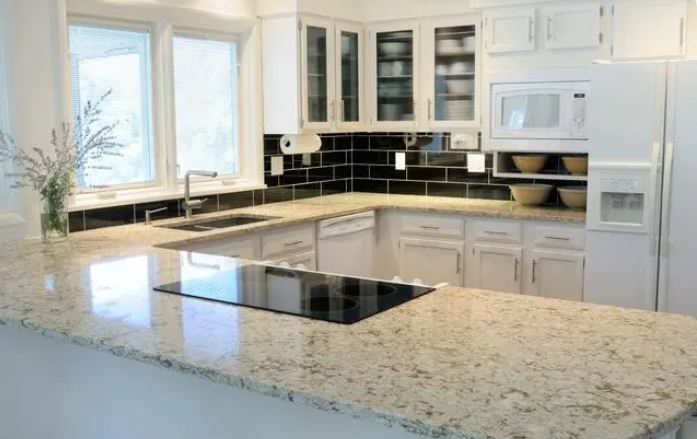Choosing the right material for your kitchen countertops is a critical decision that affects both the aesthetics and functionality of your space. Among the various options available, acrylic, granite, and quartz are popular choices, each with unique benefits and considerations. This article provides a comprehensive comparison of these three materials to help you make an informed decision.
1. Durability
Acrylic:
Acrylic kitchen countertops are known for their durability. They are resistant to stains, moisture, and bacteria due to their non-porous nature. However, they can be more susceptible to scratches and heat damage compared to granite and quartz. Minor damages on acrylic surfaces can be easily repaired by sanding and polishing.
Granite:
Granite is a natural stone that is extremely hard and durable. It is highly resistant to scratches and heat, making it an excellent choice for kitchen countertops. However, granite is porous and requires regular sealing to prevent stains and bacteria growth.
Quartz:
Quartz countertops are engineered from natural quartz combined with resins and pigments. They offer similar durability to granite but with a non-porous surface, making them resistant to stains, scratches, and bacteria without the need for sealing. Quartz is also very resistant to heat, though extreme heat can still cause damage.
2. Aesthetics and Customization
Acrylic:
Acrylic countertops are available in a wide range of colors and patterns, offering significant customization options. They can be fabricated into seamless designs, providing a sleek and modern look. The flexibility in design makes acrylic an attractive choice for those seeking a personalized kitchen aesthetic.
Granite:
Granite offers a natural and unique look, with each slab featuring distinct patterns and colors. This natural variation is a major selling point for many homeowners. However, customization is limited to the natural patterns and colors available in the stone.
Quartz:
Quartz countertops come in a variety of colors and patterns, including options that mimic the look of natural stone like granite and marble. The consistency in design allows for uniformity across large surfaces, which is a plus for some homeowners. Quartz offers a balance between the natural look of granite and the design flexibility of acrylic.
3. Maintenance
Acrylic:
Maintaining acrylic countertops is relatively simple. Regular cleaning with mild soap and water is usually sufficient. Avoiding harsh chemicals and abrasive cleaners will help preserve the surface. Periodic polishing can maintain the countertop’s shine.
Granite:
Granite requires more maintenance due to its porous nature. It needs to be sealed regularly to prevent stains and bacteria build-up. Cleaning should be done with mild detergents and avoiding acidic or abrasive cleaners.
Quartz:
Quartz countertops are low-maintenance and do not require sealing. Regular cleaning with mild soap and water is sufficient. Quartz’s non-porous surface makes it easy to maintain and hygienic.
4. Cost
Acrylic:
Acrylic countertops are generally more affordable than granite and quartz. The cost varies depending on the brand, design, and installation process but tends to be on the lower end of the spectrum for countertop materials.
Granite:
Granite is typically more expensive than acrylic but can vary widely in price depending on the type, color, and rarity of the stone. Installation costs can also be higher due to the weight and need for professional handling.
Quartz:
Quartz countertops usually fall in the same price range as high-end granite. The cost reflects the durability, low maintenance, and design versatility of the material. Like granite, professional installation is recommended, adding to the overall expense.
5. Environmental Impact
Acrylic:
Acrylic countertops can be eco-friendly if sourced from manufacturers that use recycled materials and sustainable production processes. Their long lifespan and repairability also contribute to reduced environmental impact.
Granite:
Granite extraction and transportation can have a significant environmental impact. However, its durability and longevity can offset some of these effects. Choosing locally sourced granite can reduce the environmental footprint.
Quartz:
Quartz countertops are made from abundant natural materials, but the manufacturing process involves resins and other chemicals. Some manufacturers use recycled materials and eco-friendly practices to minimize the environmental impact.

Conclusion
When comparing acrylic, granite, and quartz kitchen countertops, it’s essential to consider your priorities in terms of durability, aesthetics, maintenance, cost, and environmental impact.
Acrylic offers excellent customization options, ease of maintenance, and affordability but is less resistant to scratches and heat.
Granite provides a unique natural look and high durability but requires regular sealing and maintenance.
Quartz strikes a balance with its durability, low maintenance, and variety of designs, though it comes at a higher cost.
Ultimately, the best choice will depend on your specific needs, preferences, and budget. Each material has its strengths, making them suitable for different types of kitchens and lifestyles.
 Column
Column
 Leisure seat
Leisure seat
 Wall
Wall
 Reception
Reception